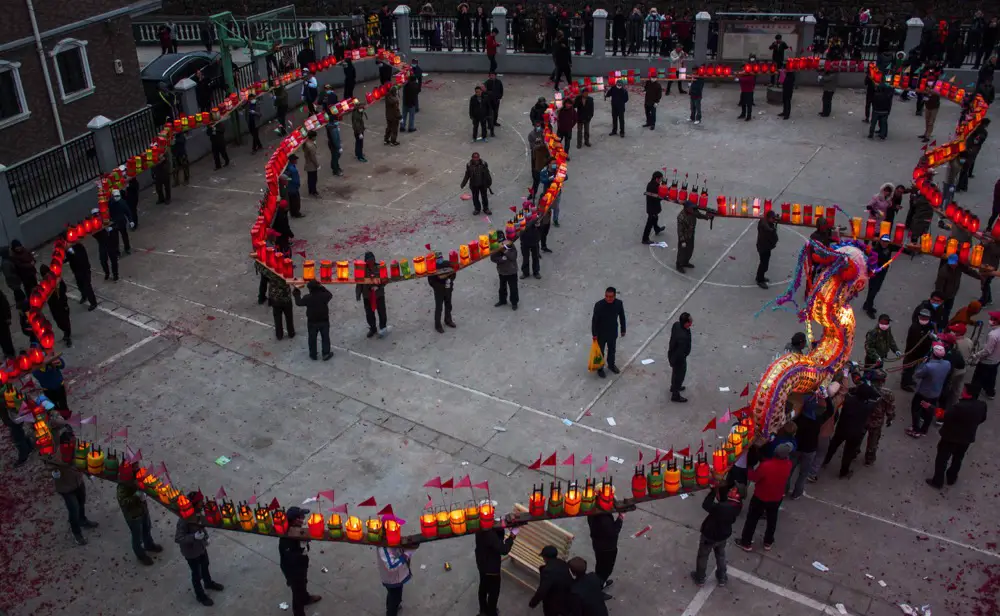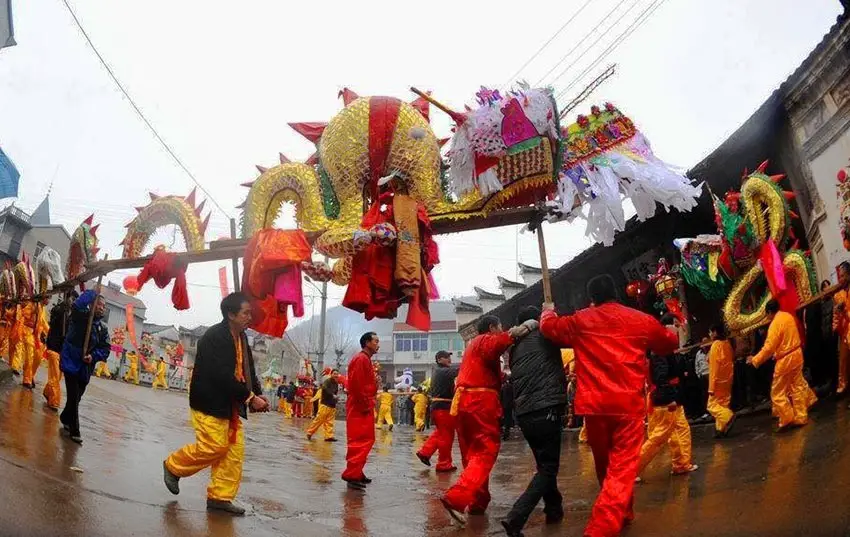The Bench Dragon, originating in the Heluo region, is a traditional folk activity widely observed during the annual festivities in various provinces and cities in southern China. This Lantern Festival custom has been practiced for several centuries. In particular, it has become a significant folk event in Fujian, embodying profound regional culture. Villagers connect bench sections by drilling holes, creating a Bench Dragon, with each household contributing a section. These dragons can stretch over 200 meters, presenting a spectacular sight.
In the Spring Festival of 2008, the “Bench Dragon” from Datian County, Sanming City, Fujian Province, was recognized as a nationally recommended intangible cultural heritage project.
The Bench Dragon is said to have originated from the Han Dynasty, evolving from religious activities like “Dragon Dance for Rain.” The tradition of Bench Dragons in Datian is believed to have been brought by ancestors from Central Plains during the period of the Eight Surnames entering Fujian. Over time, the Bench Dragon in Datian has evolved into a renowned and cherished traditional custom.
Bench Dragon History
Stool Dragon Dance, a traditional folk dance originating from Fuyang District in Hangzhou, Zhejiang Province, China, has a history spanning nearly a millennium. Its uniqueness lies in the use of long stools as props to mimic the image and movements of a dragon, showcasing the grace and posture of this mythical creature.

The history of Stool Dragon Dance can be traced back to the Song Dynasty. At that time, local residents in the Fuyang region, aiming to pray for favorable weather and a bountiful harvest, began crafting dragon heads, bodies, and tails using materials such as bamboo strips and colored paper. These components were affixed to long stools, and dancers performed the dragon dance. This dance form gradually spread and evolved through generations.
By the Ming and Qing Dynasties, Stool Dragon Dance had transformed into a folk belief and festive activity. Every major festival, including the Lunar New Year and Lantern Festival, saw spontaneous Stool Dragon Dance performances organized by Fuyang residents, seeking peace, good luck, and warding off evil spirits. Over time, the tradition expanded beyond Fuyang, becoming one of the representative folk activities in western Zhejiang.
Throughout its development, the performance style and techniques of Stool Dragon Dance have continually evolved. The original dragon head and body were relatively simple and rough, crafted from bamboo strips and colored paper. Subsequently, more exquisite materials such as silk and velvet began to be used, enhancing the overall appearance and realism of the props. Additionally, the dance movements and musical accompaniment diversified, creating a unique performance style and skill set.
In modern society, with economic development and cultural diversification, many traditional folk activities face challenges in preservation and inheritance. However, the ancient dance form of Stool Dragon Dance has been well-preserved in the Fuyang region. Local government and cultural institutions encourage the learning and inheritance of Stool Dragon Dance skills by organizing training sessions and performances. Some folk artists have also embraced Stool Dragon Dance as a career, passing down the tradition through performances and teaching.
Nevertheless, the inheritance of Stool Dragon Dance still encounters difficulties and challenges. As modernization accelerates, many young people lean towards contemporary culture and entertainment, lacking interest and understanding of traditional folk activities. Additionally, due to the resource-intensive nature of Stool Dragon Dance performances, some villages or communities struggle to bear the financial and logistical burdens required for preservation and inheritance.
To better protect and pass down the tradition of Stool Dragon Dance, more measures and methods are needed. Firstly, the government and society should intensify efforts to protect Stool Dragon Dance by providing increased financial and resource support. Education departments can incorporate Stool Dragon Dance into school curricula, ensuring that more young people are introduced to and familiar with this traditional dance form. Moreover, cultural institutions and media outlets can enhance publicity efforts to raise awareness and participation among the public.
Stool Dragon Dance Regional Spread and Craftsmanship
In the vast land of China, the unique dance form of the Stool Dragon Dance not only thrives in places like Datian County, Yong’an Qingshui She Ethnic Township, and Fuqing City in Fujian but also extends its presence across multiple provinces, including Jiangxi, Zhejiang, Chongqing, Hunan, and Guangdong. Regardless of mountainous terrains or plains, the lively performance of the Stool Dragon Dance leaves its mark, showcasing the diversity and inclusiveness of Chinese culture.
The Stool Dragon Dance, a dynamic dance form with its distinctive style and rich historical background, has captivated the attention of people. Its origins can be traced back to the Han Dynasty, evolving from religious activities like “dragon dances for rain.” This dance is not merely a form of entertainment; it carries the hopes and aspirations of people for favorable weather and abundant harvests.
In places like Datian County, Yong’an Qingshui She Ethnic Township, and Fuqing City in Fujian, the Stool Dragon Dance is a must-have performance during major festivals such as the Lunar New Year and Lantern Festival. In regions like Shangrao in Jiangxi, Yushan County, Jindong District, Wucheng District in Jinhua, and Yuxi Meixian Town, Namping in Nanping City, this dance has become an integral part of folk celebrations. Traditions such as Yuxi Meixian Town and Namping in Nanping City also retain this customary practice.

Mastering the skill of performing the Stool Dragon Dance requires exceptional body coordination and dance techniques. During the performance, dancers hold long stools, simulating the form of a dragon through rolling, jumping, and swinging movements, expressing the spirit and posture of the dragon. Accompanied by lively drumbeats and music, the dancers use their body language to narrate stories about dragons.
Beyond Fujian and Jiangxi, the Stool Dragon Dance has also spread to regions such as Ba County in Chongqing and Guidong County in Chenzhou City, Hunan. Despite the considerable geographical distances between these places, they have all preserved this unique form of folk art, demonstrating the robust vitality and broad influence of the Stool Dragon Dance.
Simultaneously, Stool Dragon Dance performances in different regions incorporate local characteristics and flavors, adding a distinct regional touch. For example, in places like Yueqing City, Songyang County in Lishui City, these performances infuse local cultural elements into prop-making and performance styles, making the dance more relatable to the lives and aesthetics of the locals.
However, with the changing times and the accelerating pace of modernization, many traditional folk art forms face the risk of disappearing. To protect and inherit this precious cultural heritage, local governments and cultural institutions are actively taking measures. Initiatives such as organizing training sessions, hosting performances, and promoting related cultural products aim to increase awareness and participation in Stool Dragon Dance performances and heritage efforts.
Furthermore, dedicated folk artists consider inheriting the Stool Dragon Dance as their mission. Through oral transmission and hands-on teaching, they pass down these skills to the younger generation. Through these efforts, many young individuals have developed a strong interest in Stool Dragon Dance, becoming inheritors and promoters of this traditional art.
Craftsmanship of the Stool Dragon
The Stool Dragon in Datian County is essentially crafted by affixing intricately designed plastic paper onto long stools, decorated with various colorful flowers. Inside, two candle holders are placed, with holes drilled at both ends, connected by wooden sticks measuring approximately 70 centimeters in length and 5 centimeters in diameter. The candles are lit as the dragon parades through the streets. With a history spanning over a millennium, this art form combines elements of painting, calligraphy, carving, and various crafts, merging sports, acrobatics, dance, and storytelling into one.
During the creation of the dragon head frame, a framework is first made on a long wooden board using bamboo strips. Subsequently, finer bamboo strips are used to add details to the framework. Earlier, the gaps between bamboo strips were tied with paper rope made from rough paper edges, but nowadays, thin iron wire is used for binding.
After completing the frame, the outer layer is covered with colored paper, transparent paper, plastic paper, and other materials. Once the outer layer is pasted, dragon scales, patterns, and other decorations are cut from colored paper and applied to the dragon’s body. These tasks are often completed by skilled women in the village. Finally, at the joints of the dragon, auspicious phrases such as “abundant harvest of the five grains” and “prosperity in livestock” are written with colored pens, marking the completion of the dragon head.
Stool Dragon Dance Techniques
The Stool Dragon Dance encompasses various styles and techniques. One such style is the Single Stool Dragon, where a common flower-patterned stool is adorned with a colorful dragon (either carved wood or paper-mâché). This dance can be performed by two to three individuals. In solo play, a person holds the front and back legs with both hands. In a duo, one person holds the front two legs, while the other holds the back two legs. In a trio, the first two individuals hold one leg each with side hands, and the last person holds both legs with both hands. Following predefined routines, dancers move in synchronization with drum beats, rhythmically and systematically showcasing various patterns.

There is also the Multi-Stool Dragon, sometimes referred to as the Long Stool Dragon, which involves an indefinite number of participants but requires at least nine individuals. Each person holds a stool. The first person leads as the dragon head, the last person acts as the dragon tail, and the rest form the dragon body. Additionally, two individuals hold a precious bead to entice the dragon’s movement. The coordinated actions of several individuals create a captivating display, moving up and down, weaving and swaying. In some cases, a single dragon may require over eighty connected stools, with wooden sticks linking each stool. Each wooden stick is held by an individual, and each stool features a lantern (representing the dragon body). These lanterns are adorned with various drawings, such as favorite flowers, trees, birds, etc. Since each lantern is uniquely designed, even when five or six dragons march together, it’s challenging to find identical patterns. In certain regions, the dragon patterns on the stools might focus on a unified motif like auspicious clouds, resembling scales, symbolizing good fortune.
During the dragon dance, as night falls, candles are lit inside the lanterns, creating an extended line of illuminated dragons. In Pujiang, there is a unique style called “miezha banded stool dragon,” where the dragon shape is intricately crafted using bamboo strips, placed on top of a stool, and wooden feet represent dragon claws, achieving a lifelike appearance. One particularly famous branch of the Stool Dragon is the folk Stool Dragon in Shagou, Xinghua, Jiangsu. Originating from the East Yue Temple Fair in the late Ming and early Qing dynasties, this tradition has a history of over three hundred years. Shagou’s “Stool Dragon” is listed in the provincial and municipal intangible cultural heritage protection catalog. The Stool Dragon dance team in Shagou Town, Xinghua City, represented Taizhou City in the 3rd Jiangsu Provincial Innovation Project Exhibition and Performance for National Fitness, winning awards for excellent performance and outstanding innovation.